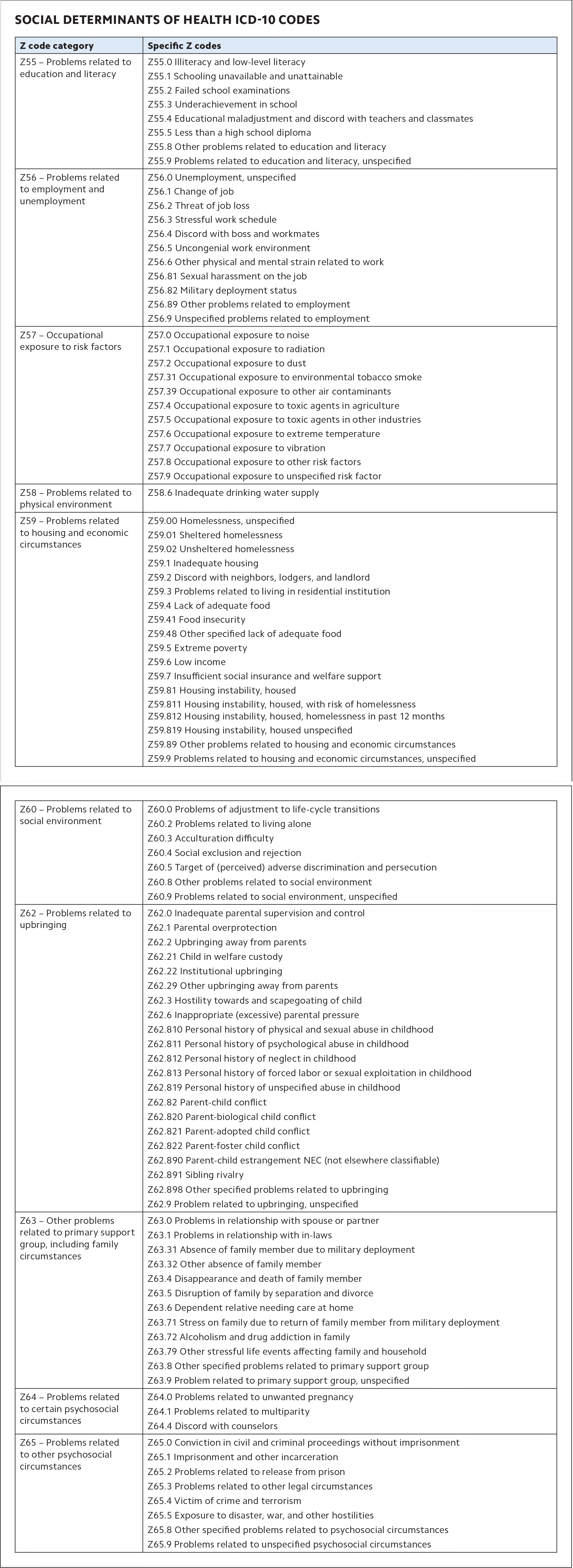
Social factors often have greater influence on patients' health than medical care. Identifying those factors is the first step to addressing them.
Fam Pract Manag. 2022;29(2):6-11
Author disclosure: no relevant financial relationships.

Having a clear picture of your patients' socioeconomic needs is key to improving their health outcomes. Lack of food, housing, clean water, transportation, and employment, among other challenges, can have significant downstream effects on otherwise healthy patients. For those with chronic conditions, socioeconomic factors are even more crucial because they hinder lifestyle changes that are often first-line treatments for those conditions. For example, patients with type 2 diabetes may be unable to control their A1C if they cannot afford their medications or do not have access to healthy groceries.
Non-medical conditions that significantly affect health and quality of life are called social determinants of health (SDOH). According to the U.S. Department of Health and Human Services, SDOH fall into five categories: economic stability, health care access and quality, education access and quality, neighborhood and built environment, and social and community context.1 Within these categories are basic needs such as safety, transportation, food, and housing.
The Robert Wood Johnson Foundation estimates social needs account for as much as 80% of health outcomes.2 If social needs are not met, physicians and other providers will be largely unable to improve outcomes. This is bad for patients, and makes it harder for physicians to succeed in value-based payment arrangements.3 Thus, identifying and addressing SDOH should be an integral part of family medicine practices.
But how do you have a meaningful conversation with your patient about SDOH during a 15-minute visit when other problems also need to be addressed? It starts with screening.
KEY POINTS
Social determinants of health (SDOH) can have a big impact on patient outcomes, so identifying and addressing them is key, especially as more payers move to value-based payment systems.
Several screening tools are available to help practices identify social needs and facilitate conversations with patients.
ICD-10 “Z” codes (Z55-Z65) can be used to document social determinants of health and give practices accurate data on the needs of their patient population.
WHY AND HOW TO SCREEN FOR SDOH
The rationale for SDOH screening is simple: If you don't ask, you won't know. And if you do not know about a patient's social needs, you cannot address them and provide the best care. You may be spinning your wheels trying to get a patient's blood pressure under control if you do not know that the patient is struggling with homelessness or unemployment, not simply making poor dietary choices or forgetting to take medication. Patients may not volunteer this information because they do not see the connection between SDOH and their health. This is why practices need to be proactive in assessing social needs. Screening for SDOH should be a routine part of patient registration, rooming, obtaining a social history, and seeing the patient.
Screening tools. SDOH screening tools can be administered by clinic staff or completed by the patient prior to the visit. Your EHR likely has an integrated SDOH screening tool. For instance, several common EHRs include templates with a few basic questions to assess family life, housing situation, education level, employment status, health insurance status, financial status, safety, legal issues, reliability of transportation, and ability to pay for food, utilities, and medication. These tools can be used to document social needs and communicate them to other members of the care team.
If your EHR doesn't have an integrated screening tool, or if it's inadequate, here are some other options:
Workflow integration. There are several different ways to incorporate SDOH screening into your workflow:
Make the screening tool part of the health risk assessment that patients complete prior to Medicare annual wellness visits,
Have staff send patients the screening tool electronically for completion prior to the visit and review the answers as part of pre-visit planning, noting which issues need to be addressed during the visit,
Make SDOH screening questions part of the rooming process for medical assistants or nurses.
Once the screening tool is completed, you can use the results to have a focused conversation with the patient about SDOH needs.
HELPING PATIENTS FIND RESOURCES
Screening alone is not enough. Practices should also be able to help patients access resources to fill gaps that are discovered through screening. Physicians do not have to be one-stop shops for social support. But they should know where to send patients within the community. Keeping an updated list of local resources can seem arduous, but several websites provide this information based on location (see “How to find resources in your area”).
Some EHRs offer links to community resources, searchable by topic and ZIP code. Some practices have social workers or patient navigators in the clinic to help connect patients with local service providers. Others have gone a step further and provide services in their own clinics, such as food pantries stocked with healthy options or in-clinic pharmacy and lab services so patients with transportation challenges only have to make one trip.
Hiring a social worker or stocking a food pantry may not be an option for everyone, but all practices can train front-desk staff or other clinic workers to link patients with community resources during checkout.
HOW TO FIND RESOURCES IN YOUR AREA
CODING AND DOCUMENTING SDOH
Once you've screened for SDOH and connected patients to appropriate resources, it's important to document SDOH in the chart.
Proper documentation and coding of SDOH helps a practice coordinate care across the health care team and better quantify the social needs of its patient population. The ICD-10 manual includes “Z” codes that were created to identify SDOH. These codes (Z55-Z65) fall under the category of “persons with potential health hazards related to socioeconomic and psychosocial circumstances.” They describe problems with education, employment, housing, finances, upbringing, family life, and legal issues. (See “Social determinants of health codes.”)
Using Z codes can spur the creation of resources to address social needs. For example, if physicians are routinely coding patient issues related to housing (e.g., Z59.01 – sheltered homelessness or Z59.1 – inadequate housing), a health system or payer analyzing this data may decide to partner with community groups to provide housing assistance for patients.
Coding for SDOH is also important for leveling visits. The 2021 outpatient office E/M code revisions include SDOH as part of medical decision making (MDM). If a diagnosis or treatment is significantly limited by SDOH, this contributes to the complexity of the visit, taking the risk component to a level 4 (99204/99214).
The Centers for Medicare & Medicaid Services has outlined how SDOH data can be collected and used.4 Any member of the patient's care team can collect SDOH data during any encounter, including physicians, nonphysician providers, nurses, social workers, community health workers, case managers, and patient navigators. Patients can self-report the data or practices can collect it through screening tools or face-to-face interactions. Coders can also translate SDOH information in the patient's chart into Z codes. This data can then be analyzed to identify patient needs, connect them to appropriate resources, or create resources to assist with these needs (food pantries, medical transportation, etc.).
This is not a perfect system, as many SDOH issues do not yet have ICD-10 codes, but it is progress.

| Z code category | Specific Z codes |
|---|---|
| Z55 – Problems related to education and literacy | Z55.0 Illiteracy and low-level literacy Z55.1 Schooling unavailable and unattainable Z55.2 Failed school examinations Z55.3 Underachievement in school Z55.4 Educational maladjustment and discord with teachers and classmates Z55.5 Less than a high school diploma Z55.8 Other problems related to education and literacy Z55.9 Problems related to education and literacy, unspecified |
| Z56 – Problems related to employment and unemployment | Z56.0 Unemployment, unspecified Z56.1 Change of job Z56.2 Threat of job loss Z56.3 Stressful work schedule Z56.4 Discord with boss and workmates Z56.5 Uncongenial work environment Z56.6 Other physical and mental strain related to work Z56.81 Sexual harassment on the job Z56.82 Military deployment status Z56.89 Other problems related to employment Z56.9 Unspecified problems related to employment |
| Z57 – Occupational exposure to risk factors | Z57.0 Occupational exposure to noise Z57.1 Occupational exposure to radiation Z57.2 Occupational exposure to dust Z57.31 Occupational exposure to environmental tobacco smoke Z57.39 Occupational exposure to other air contaminants Z57.4 Occupational exposure to toxic agents in agriculture Z57.5 Occupational exposure to toxic agents in other industries Z57.6 Occupational exposure to extreme temperature Z57.7 Occupational exposure to vibration Z57.8 Occupational exposure to other risk factors Z57.9 Occupational exposure to unspecified risk factor |
| Z58 – Problems related to physical environment | Z58.6 Inadequate drinking water supply |
| Z59 – Problems related to housing and economic circumstances | Z59.00 Homelessness, unspecified Z59.01 Sheltered homelessness Z59.02 Unsheltered homelessness Z59.1 Inadequate housing Z59.2 Discord with neighbors, lodgers, and landlord Z59.3 Problems related to living in residential institution Z59.4 Lack of adequate food Z59.41 Food insecurity Z59.48 Other specified lack of adequate food Z59.5 Extreme poverty Z59.6 Low income Z59.7 Insufficient social insurance and welfare support Z59.81 Housing instability, housed Z59.811 Housing instability, housed, with risk of homelessness Z59.812 Housing instability, housed, homelessness in past 12 months Z59.819 Housing instability, housed unspecified Z59.89 Other problems related to housing and economic circumstances Z59.9 Problems related to housing and economic circumstances, unspecified |
| Z60 – Problems related to social environment | Z60.0 Problems of adjustment to life-cycle transitions Z60.2 Problems related to living alone Z60.3 Acculturation difficulty Z60.4 Social exclusion and rejection Z60.5 Target of (perceived) adverse discrimination and persecution Z60.8 Other problems related to social environment Z60.9 Problems related to social environment, unspecified |
| Z62 – Problems related to upbringing | Z62.0 Inadequate parental supervision and control Z62.1 Parental overprotection Z62.2 Upbringing away from parents Z62.21 Child in welfare custody Z62.22 Institutional upbringing Z62.29 Other upbringing away from parents Z62.3 Hostility towards and scapegoating of child Z62.6 Inappropriate (excessive) parental pressure Z62.810 Personal history of physical and sexual abuse in childhood Z62.811 Personal history of psychological abuse in childhood Z62.812 Personal history of neglect in childhood Z62.813 Personal history of forced labor or sexual exploitation in childhood Z62.819 Personal history of unspecified abuse in childhood Z62.82 Parent-child conflict Z62.820 Parent-biological child conflict Z62.821 Parent-adopted child conflict Z62.822 Parent-foster child conflict Z62.890 Parent-child estrangement NEC (not elsewhere classifiable) Z62.891 Sibling rivalry Z62.898 Other specified problems related to upbringing Z62.9 Problem related to upbringing, unspecified |
| Z63 – Other problems related to primary support group, including family circumstances | Z63.0 Problems in relationship with spouse or partner Z63.1 Problems in relationship with in-laws Z63.31 Absence of family member due to military deployment Z63.32 Other absence of family member Z63.4 Disappearance and death of family member Z63.5 Disruption of family by separation and divorce Z63.6 Dependent relative needing care at home Z63.71 Stress on family due to return of family member from military deployment Z63.72 Alcoholism and drug addiction in family Z63.79 Other stressful life events affecting family and household Z63.8 Other specified problems related to primary support group Z63.9 Problem related to primary support group, unspecified |
| Z64 – Problems related to certain psychosocial circumstances | Z64.0 Problems related to unwanted pregnancy Z64.1 Problems related to multiparity Z64.4 Discord with counselors |
| Z65 – Problems related to other psychosocial circumstances | Z65.0 Conviction in civil and criminal proceedings without imprisonment Z65.1 Imprisonment and other incarceration Z65.2 Problems related to release from prison Z65.3 Problems related to other legal circumstances Z65.4 Victim of crime and terrorism Z65.5 Exposure to disaster, war, and other hostilities Z65.8 Other specified problems related to psychosocial circumstances Z65.9 Problems related to unspecified psychosocial circumstances |
PATIENT EXAMPLES
Here are some examples of how screening for SDOH and providing resources can help improve patients' health.
Patient 1: A 50-year-old male established patient comes in for an annual preventive medicine visit. He has gained a significant amount of weight in the past year, and pre-visit labs show that he is now pre-diabetic. On the screening tool that he filled out prior to the visit, you see he has marked that he is now unemployed and in the past year has often worried that his food would run out before he had enough money to buy more. He has also marked that he would like assistance with this.
During the visit you tell the patient about the lab results. You ask about his screening tool answers and whether losing his job impacted his ability to buy groceries. The patient offers that he has been stressed since losing his job. He has been looking to cut costs and has started to buy cheaper food, which is mostly processed.
You explain to the patient how the change in his diet is affecting his weight and blood sugar and increasing his risk of diabetes. You give the patient handouts on nutrition and low glycemic foods, along with a list of websites to learn more about preventing diabetes. You refer him for nutrition counseling at the local YMCA and provide a list of food pantries with fresh produce and the contact information for the state employment agency. You ask the patient to follow up in three months and reach out via the EHR portal if he needs additional assistance. He agrees with this plan. You assign additional diagnosis codes to this visit to communicate SDOH concerns: Z56.0 – unemployment, unspecified; Z59.6 – low income; and Z59.41 – food insecurity.
Patient 2: A 73-year-old female patient comes in for a post-hospital discharge visit after being hospitalized for the flu. She has a history of uncontrolled hypertension, though she has regular visits with her primary care physician. As part of the pre-visit check-in process, she completed the PRAPARE form, where she indicated that transportation issues sometimes prevent her from getting to her medical appointments and getting her medication.
After reviewing the hospital discharge notes with the patient, you ask about her transportation challenges. She says she lives alone and is afraid to drive due to increased traffic in her area, so she has to rely on friends to take her to appointments and get her prescriptions, and they are not always reliable. This is why she has not received her flu vaccine this year. You ask about her insurance coverage and find out she is enrolled in a Medicare Advantage plan. You discuss with her the possibility of taking public transportation to her visits or contacting her insurance company, because it may provide transportation for medical appointments. You also know that her plan includes the option of mail-order prescriptions and encourage her to contact her pharmacy to have her medications shipped directly to her house and avoid the additional trip. You discuss the importance of medication adherence to control her blood pressure. She agrees with this plan. There are no specific SDOH diagnosis codes for transportation issues, but other codes can help capture her social issues. In this case, you use code Z60.2 – problems related to living alone.
IN SUMMARY
To provide the best care, physicians and practices need to screen for and document patients' social needs. By screening for SDOH, you will be able to identify social needs that negatively affect health outcomes and use the information to leverage additional resources for your patients.
